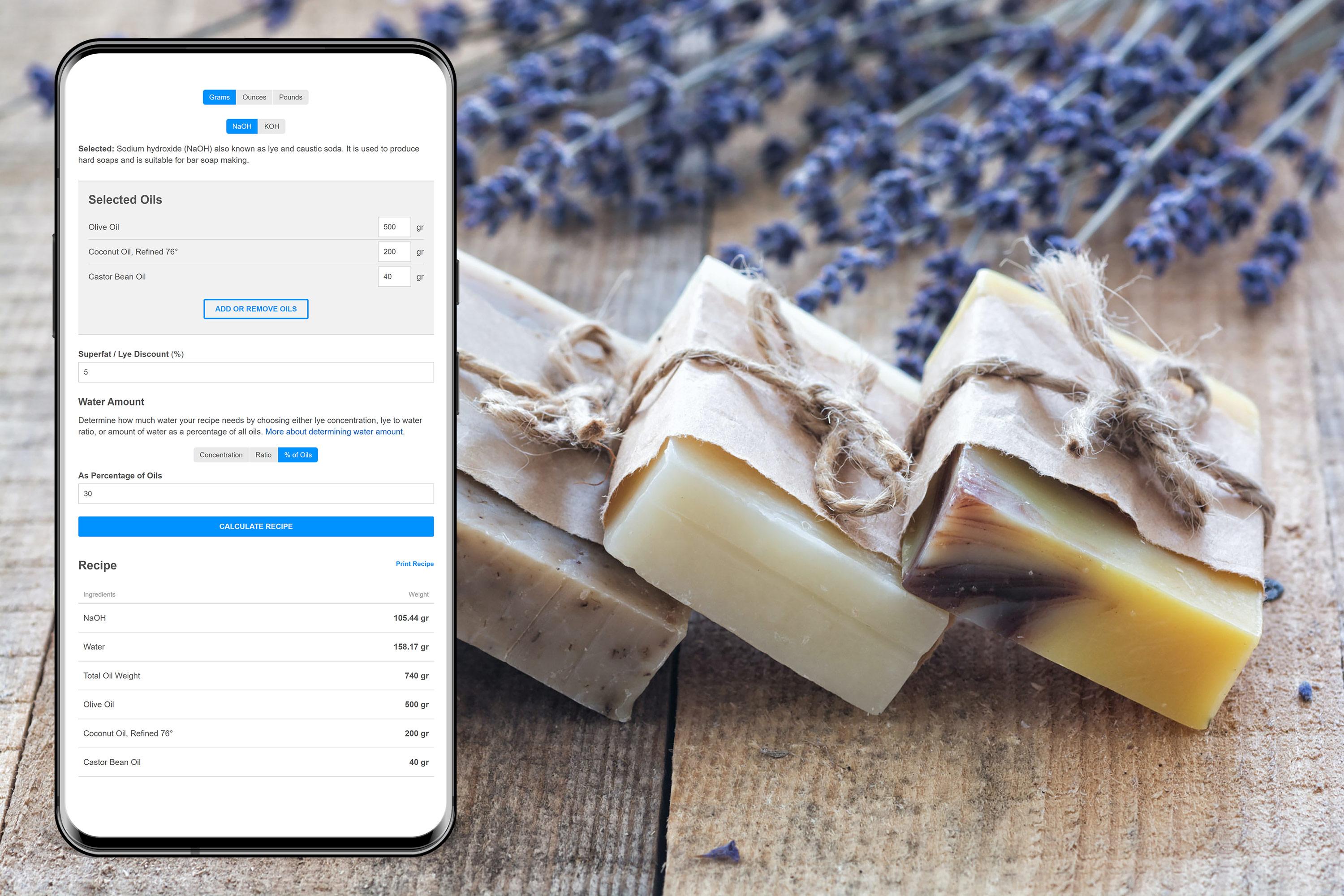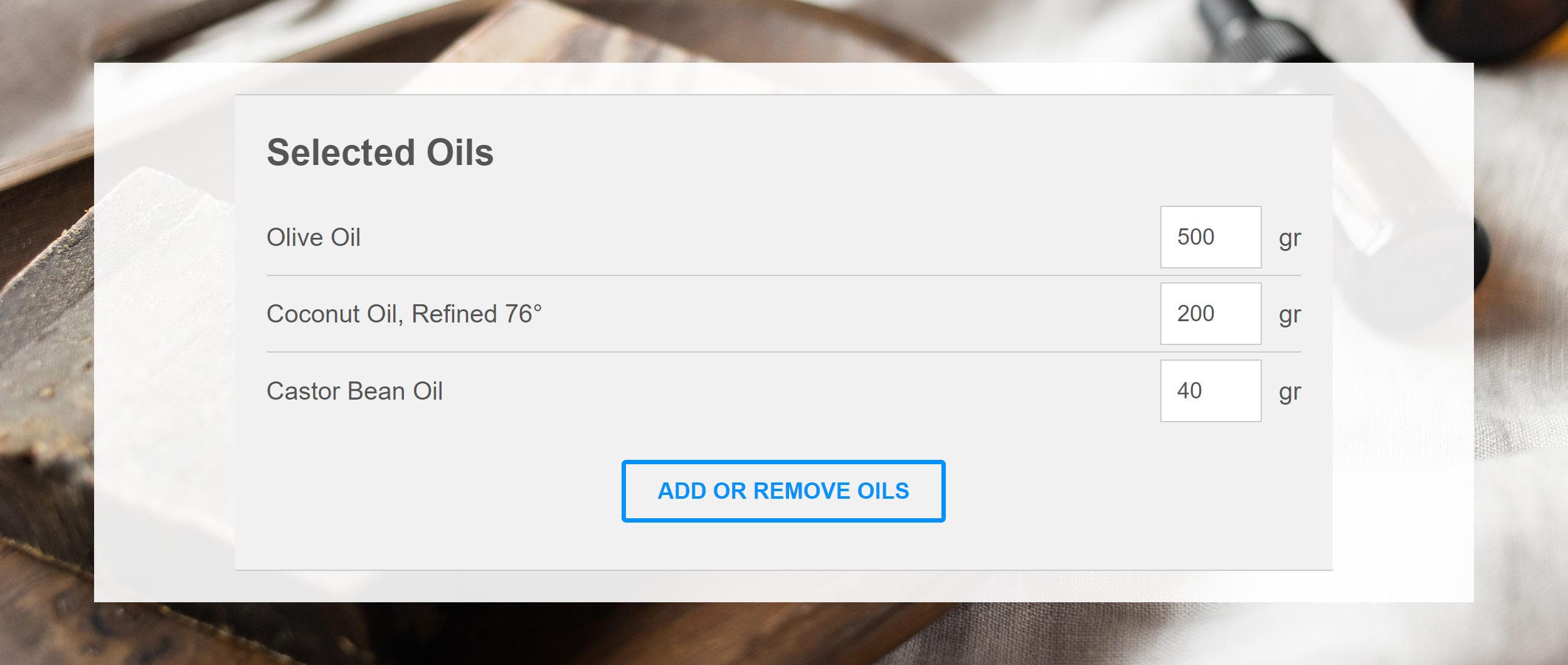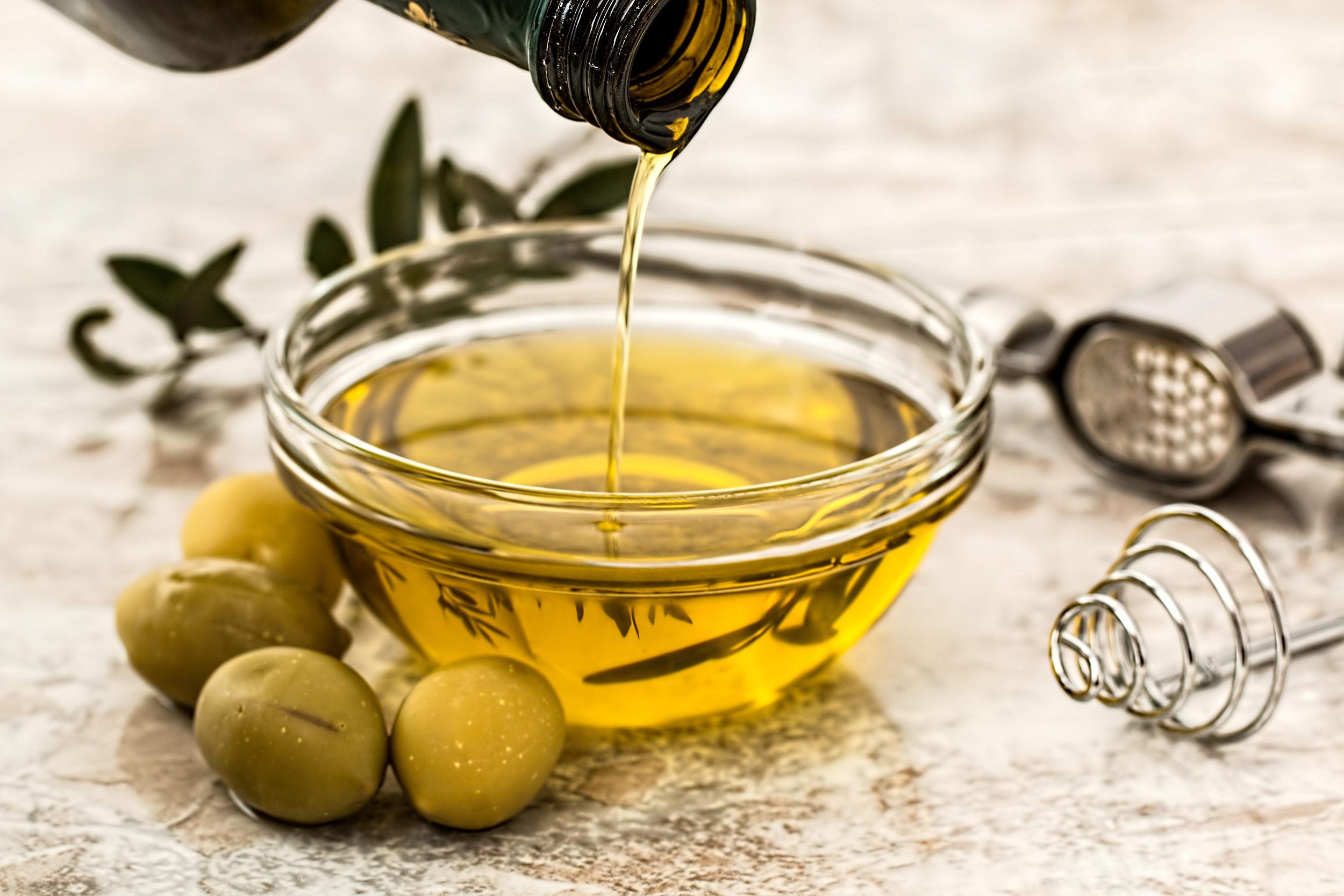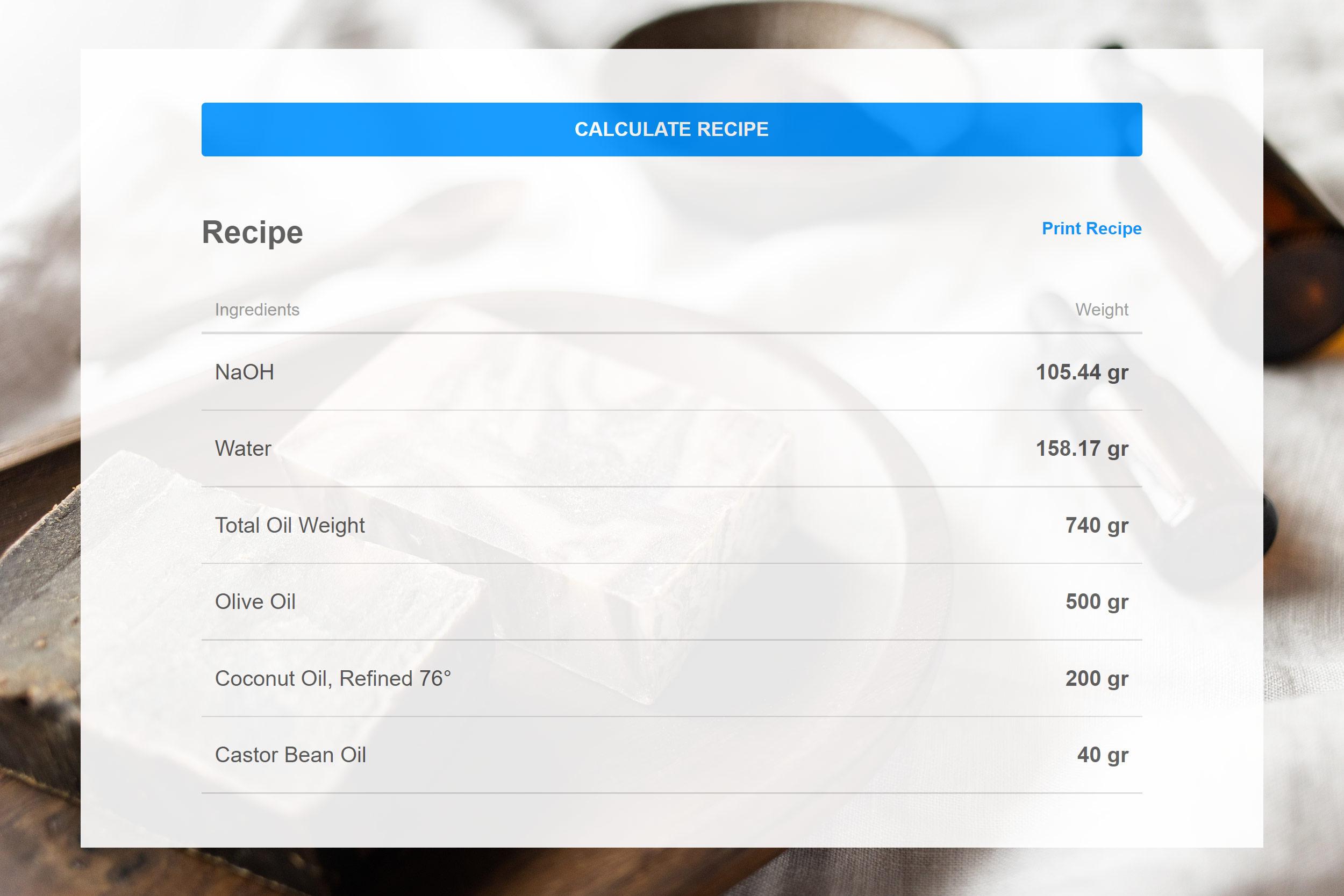Create Your Own Soap Recipes With This Soap Recipe Calculator
by aseev in Craft > Soapmaking
4926 Views, 6 Favorites, 0 Comments
Create Your Own Soap Recipes With This Soap Recipe Calculator

If you rely on somebody else's recipes and are ready to move on to the next step, this instructable will help you experiment with different fats and oils and create your own recipes for cold process soap making.
This instructable is a guide for using soap recipe calculators and for understanding the fancy terms like saponification, superfat or lye discount, solution concentration, ratios, and so on.
Supplies

There are several soap recipe calculators but they all lack something that a good application should have. They are either too complex and difficult to understand without prior knowledge of soap making, or too basic. And most of them don't work on mobile devices.
I created a calculator with a simple, intuitive interface that can be used on any device and shouldn't scare off novice soap makers. We will use the calculator in this guide but you will be able to apply the knowledge to any other calculator.
Select Measurement Units

Once you open the calculator - we can start creating a soap recipe. Let's start by selecting the measurement units. Choose what you like, the process is the same for any of them. I prefer the metric system and will use grams in this instructable.
Select a Base That You Will Use in the Recipe

Now we need to select a base that you will use in the recipe. You have two choices - NaOH and KOH.
NaOH - is the chemical formula of sodium hydroxide (also known as lye and caustic soda. It is used to produce hard soaps and is suitable for bar soap making. Most people use this chemical in their recipes.
KOH is the formula for potassium hydroxide. It is the precursor for most soft and liquid soaps.
For this instructable I will use sodium hydroxide (NaOH), or simply lye, to create a hard bar soap.
Add or Remove Oils

The next step is to select oils and fats for your recipe. What you use in your soap recipes is entirely your choice, any natural base oil or fat can be used to make soap. Using different oils and fats will give your soaps with different properties. Experiment and create unique recipes.
Click the big button "Add or Remove Oils" and you will see the list of oils to chose from. It is a large list and using the search bar will make selecting oils faster.
Enter the Weight of Each Oil

After you select the oils from the list, they will appear under "Selected Oils" sections. These oils will be part of your recipe and you need to enter the weight of each oil.
What Is Saponification?

If you are already making soap you know what saponification is, but let's review this one more time before we move on to the other parameters in the calculator.
What is Saponification?
Saponification is a chemical process where fats and oils, mixed with a lye solution, turn into soap. Different types of fats and oils require a different amount of lye for complete saponification. Therefore different types of fats oils have different saponification values.
Saponification Values
The saponification value is the amount of lye in milligrams required to saponify one gram of fat or oil.
What Is Superfat or Lye Discount?

Superfatting or lye discounting is the process of using less lye than required to saponify the whole amount of oils in your batch. For example, to saponify 500 grams of olive oil you will need 68 grams of sodium hydroxide. If you decide to superfat your batch of soap by 5% you will simply use 5% less lye, in this case, 64 grams. Using less lye will leave unsaponified oil in the soap after saponification is complete.
The Reason for Superfatting
Why superfatting or lye discounting is needed? Superfatting serves several purposes.
The amount of lye needed for complete saponification depends on the lye purity and properties of the oil. Even the same type of oil may vary slightly in its true saponification value. So, the same type of oil from one manufacturer may require a slightly different amount of lye than oil from another manufacturer.
It is difficult to calculate exact amounts and it is important to prevent an excess of lye. Lye is highly corrosive and will irritate or burn the skin if present in the soap.
Having a certain percentage of extra fats and oils ensures that every lye molecule has enough oil molecules for reaction. Therefore superfatting or lye discounting acts as a buffer, preventing an excess of lye by allowing for a slight surplus of oils.
An excess of oils is not an issue and is even desirable as they add moisturizing qualities to the soap. Some types of oils may even require a higher superfat amount to improve soap qualities. For example, soaps with high content of coconut oil could be too drying, very cleansing, and harsh on some people's skin. Leaving some free oils in the soap will mitigate these issues, making it more conditioning and less cleansing.
Keep in mind, overly high superfat percentage will leave too many free oils and may cause the soap to spoil, reduce the lather, and make the bar of soap too soft and greasy.
The common superfat percentage ranges from 3-20%.
Water Amount

Another important ingredient in a soap recipe is water. Lye must be dissolved in water so it can react with oils to begin the saponification process.
The calculator helps you determine how much water your recipe needs by choosing the type of your lye solution - as lye concentration, lye to water ratio, or amount of water as a percentage of all oils.
Before we review each solution type, it is important to know that the minimum amount of water you can use to dissolve lye completely is equal to the amount of lye, or be a 50% solution, or be 1:1 ratio. Otherwise, lye will not dissolve completely and the soap may contain unsaponified lye. And we have learned that this is bad.
Water Amount by Lye Concentration

The concentration of a solution is the percent of a solute (lye) in the solvent (water). For example, if your lye solution consists of 30% of lye and 70% of water - the lye concentration is 30%. Select this option if you prefer using lye concentration as the type of solution and the calculator will calculate the required amount of water.
Water Amount by Lye to Water Ratio

Lye to water ratio is similar to lye concentration. But instead of percentages, we are using parts of lye and parts of water. If we use an equal weight of lye and an equal weight of water, or in other words, one part of lye and one part of water - the ratio will be 1 to 1. To make a 1 to 2 ratio - we will need to use twice as much water as lye.
Water Amount As Percentage of Oils

When this option is selected, you determine the amount of water based on the amount of oils in your recipe. For example, if you decide to use water as 30% of the weight of all oils and you use 1000 grams of oils in your recipe - the amount of water will be 300 grams. Or 30% of 30 ounces of all oils in your recipe equals 9 ounces of water.
Using water as a percentage of oils is not a good measure for calculating the lye solution. Because, as we learned earlier, different oils require different amounts of lye for saponification and, therefore, different recipes will require different amounts of lye.
For example, a soap that uses only olive oil at 30% water-to-oils produces a 30% lye concentration or 1:2.3 lye to water ratio, whereas a coconut oil soap with 30% water-to-oils produces a 36.7% lye concentration or 1:1.7 lye to water ratio.
Although the amount of water as a percentage of oils will be the same for all recipes, the lye solution may be much weaker or stronger depending on the oils you will use in your recipe.
Calculate Your Recipe

The only step left is pressing the "Calculate Recipe" button. After clicking the button you will see the recipe with your ingredients and the amounts of lye and water needed to saponify the oils you selected. And this how easy it is to formulate your own cold process soap recipes.